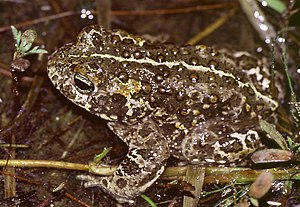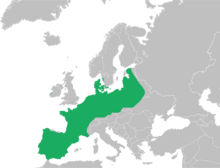Natterjack toad
| Natterjack toad | ||||||||||||
|---|---|---|---|---|---|---|---|---|---|---|---|---|

Natterjack toad ( Epidalea calamita ) |
||||||||||||
| Systematics | ||||||||||||
|
||||||||||||
| Scientific name of the genus | ||||||||||||
| Epidalea | ||||||||||||
| Cope , 1864 | ||||||||||||
| Scientific name of the species | ||||||||||||
| Epidalea calamita | ||||||||||||
| ( Laurenti , 1768) |
The natterjack toad ( Epidalea calamita , Syn . : Bufo calamita ) is the only species of the genus Epidalea within the toad family (Bufonidae). It is common in Western , Northeastern and Central Europe.
features

The size of the males ranges from four to seven centimeters, those of the females from five to eight centimeters. The back is marbled brown or olive on a lighter background. The surface of the skin is dry and warty. The large warts and parotids on the back of the head are sometimes reddish in color. As a rule (but not always) there is a thin yellow longitudinal line over their "cross" (the back). The body is compact, the head sloping sharply forward, the muzzle rounded, the pupil horizontally elliptical, the iris lemon-yellow to greenish. The hind legs are especially short for toad conditions, so that natterjack toads rarely hop, but typically move forward crawling like a mouse.
distribution
The distribution of the species extends in western, central and northeastern Europe from the Iberian Peninsula over the southern tip of Sweden to the Baltic States and Belarus . In Germany, the natterjack toad occurs in large parts - although it is scattered and unsteady; There are gaps especially in low mountain ranges. In many regions, stocks appear to be in decline.
On some North Sea islands with dune landscapes, however, the natterjack toad is the most common amphibian species. Contrary to previous assumptions, however, this is not due to a particularly high salt tolerance, but to the fact that the dunes and sandy foreland give the natterjack toad an advantage over other amphibian species.
habitat
Just as the green toad , the natterjack toad, a pioneer species is warm, open habitats in areas with loose and sandy soils. The existence of biotopes with little or no vegetation with sufficient hiding places as land habitats as well as hardly overgrown shallow and small water bodies as spawning grounds is a prerequisite for the existence of the natterjack toad.
The preference for very shallow, small bodies of water for laying the spawning lines on the one hand harbors the risk of drying out before the larvae have completed their metamorphosis. On the other hand, such habitats offer the advantage that they warm up very quickly and there are no predators in the water. The loud call of the natterjack toads is adapted to mating in annually changing waters - the partner must not only be lured to the male toad, but also to the corresponding unknown water. Excavation areas, inland dunes , post-mining landscapes , fallow land, construction sites, military training areas, coastal dunes , salt marshes and ruderal areas in human settlement areas are settled. The species is sometimes found even in structurally poor agricultural landscapes, provided that suitable spawning habitats are available. The habitats mentioned are secondary biotopes. The natterjack toad is originally a species of floodplain landscapes, which have become very rare today due to the straightening and containment of rivers and the construction of barrages, in which they find optimal reproductive conditions in open, dry, warm, mostly sandy locations.
Reproduction


At spawning time, the males use a large, blue-colored, throat-shaped sound bladder to produce loud mating calls to attract the attention of females willing to reproduce. The series of calls can be rewritten as loud metallic rattling (“arr… arr… arr”). Nocturnal natterjack toad chants can sometimes be heard almost two kilometers away. In Central Europe, the main calling period is April and May. Depending on the weather, an earlier call start (end of March) is possible or there are further call and spawning periods in the summer months - triggered by extensive rain phases. The sounds of the calls can be confused with those of the goat milker .
The one or two-row, pearl-like, one to two meter long spawning cords are laid directly on the bottom of the water in shallow water, without reference to plant stems or other vertical structures. They are not always clearly distinguishable from those of the common toad , which normally spawns earlier and the egg cords are preferably anchored to somewhat deeper water points between stems and submerged branches. The number of black eggs is between 2800 and 4000, with the egg diameter ranging from one to 1.7 millimeters.
The dark, small tadpoles also resemble those of the common toad; From the stage of maturity with hind legs, however, they often have an indistinct, light throat spot. Their length including the oar tail is up to 36 millimeters. With favorable external conditions, natterjack tadpoles need only three to six weeks to metamorphose . The duration of larval development is influenced, among other things, by the water temperature, the food supply, the population density, the competition with other larvae and the threat of drying out of the water. The minimum development time in the field is 17 days, and a maximum of 84 to 100 days.
Hazard and protection
As pioneering colonizers of arid biotopes with little vegetation and smaller, often sporadic accumulations of water (“ puddles ”), natterjack toads suffer from the lack of suitable spawning waters or from the fact that their habitats are covered with bushes and shaded. However, they are particularly affected by interventions such as the recultivation or conversion of fallow land and former excavation pits. Since the river floodplains in Central Europe are often severely impaired in their hydrological and surface structural dynamics due to straightening and dyke construction, natural habitats for natterjack toads can usually no longer arise there.
Legal protection status (selection)
- Fauna-Flora-Habitat Directive (FFH-RL): Annex IV (species to be strictly protected)
- Federal Nature Conservation Act (BNatSchG): strictly protected
National Red List classifications (selection)
- Red List Federal Republic of Germany: V - Warning List
- Red List of Austria: CR (corresponds to: critically endangered)
- Red list of Switzerland: EN (corresponds to: highly endangered)
swell
Individual evidence
- ↑ Miguel Vences : The Amphibian Tree of Life: Ideology, Chaos or Biological Reality? In: Zeitschrift für Feldherpetologie 14, issue 2 . Laurenti, 2007, ISSN 0946-7998 , p. 153-162 .
- ↑ a b c Uwe Dierking: The natterjack toads in the foreland of St. Peter-Ording . In: Federal Environment Agency and national park administrations of Lower Saxony Wadden Sea / Schleswig-Holstein Wadden Sea (ed.): Wadden Sea Environment Atlas . Vol. 1: North Frisian and Dithmarsches Wadden Sea . Eugen Ulmer, Stuttgart 1998/1999, ISBN 3-8001-3491-8 , pp. 130-131.
- ^ Habitat for Natterjack Toad in Nature Conservation Information NRW
- ↑ Ulrich Sinsch: Biology and ecology of the natterjack toad. Laurenti-Verlag, Bochum 1998. ISBN 3-933066-01-8
- ↑ Kreuzkröte at wisia.de
- ↑ Federal Agency for Nature Conservation (ed.): Red list of endangered animals, plants and fungi in Germany 1: Vertebrates. Landwirtschaftsverlag, Münster 2009, ISBN 978-3-7843-5033-2 .
- ↑ Online overview at amphibienschutz.de
literature
- Rainer Günther (Ed.): The amphibians and reptiles of Germany. Gustav Fischer Verlag Jena, 1996. ISBN 3-437-35016-1 .
- Klaus Lörcher, Hans Schneider: Comparative bio-acoustic studies on the natterjack toad, Bufo calamita (Laur.), And the green toad, Bufo v. viridis (Laur.). In: Zeitschrift für Tierpsychologie, Volume 32, 1973, pp. 506-521.
- Andreas Nöllert, Christel Nöllert: The amphibians of Europe. Franckh-Kosmos, 1992. ISBN 3-440-06340-2 .
- Hans Schneider: Bioacoustics of the Froschlurche - native and related species. With audio CD. Supplement to the Zeitschrift für Feldherpetologie 6. Laurenti Verlag, Bielefeld 2005. ISBN 3-933066-23-9 .
- Ulrich Sinsch: Biology and ecology of the natterjack toad. Laurenti-Verlag, Bochum 1998. ISBN 3-933066-01-8 .
Web links
- Darrel R. Frost: Epidalea calamita , Amphibian Species of the World, Version 6.0, American Museum of Natural History, 1998-2014, accessed April 24, 2014
- Photos of the natterjack toad at www.herp.it
- Information on the natterjack toad in Austria at www.herpetofauna.at
- Epidalea calamita in the endangered Red List species the IUCN 2010. Posted by: Beja, P. et al ., 2008.




